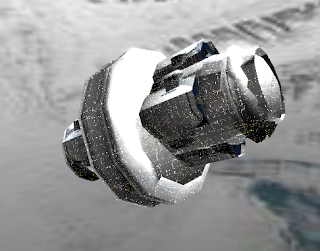Zetan
The Zetan (singular and plural; Zetan is the name of the collective race, roughly equivalent to "Human" and "Humanity", although these beings are quite different from our traditional understanding of species) are a race of Inter-Dimensional beings closely related to the Prometheans that look a lot like Saucer Men from 20th Century Earth folklore. Other than their strange green skin and large, glowing, almond-shaped eyes structures they look very much like humans with a general hominid body layout, yet are different enough to unsettle most humans.
 |
| The Zetan had apparently visited Terra for thousands of years, but began to be seen on a larger scale during the 02000s and 02100s. A shy and inquisitive race by nature, the Zetan avoided most direct contact with Humanity during this era. | | |
|
|
Promedians
The Prometheans are a trader race that plies the transit routes of deep space. Little is known about their actual homeworld or even which part of the galaxy they originate from. It is known that they share an ancestry with the Zetans, who appear to be based in the Sirius star system. What is known is that at some point during the mid-21st century they showed up on the scene as the first alien race to contact humanity and assisted in the efforts to locate the ancient Hypergate of the Solar System. It has been noted that they appear to 'adopt' other races, caring for them and guiding their development as they have done with humans and perhaps other races. Whether they do this purely for altruistic reasons, or as part of their efforts to further their trading empire is unknown.
 |
| Promedian ships became common sights throughout the latter part of the 02100s. An ancient and powerful race, the Promedians were divided into two major factions, split between their respective homeworlds of Chi Draconis and 40 Eridani. |
|
|
Kentaurans
The Kentaurans are humanoids that appear to be virtually identical to Humans living among the worlds of Alpha Centauri, essentially right next door to the Solar System in cosmic terms. In fact, there are known stories of Kentaurans and Humans interbreeding and producing fertile offspring. So it seems that the Alphan Imperium is populated by common Homo Sapiens, such as those found on Earth.
The chances of this being a random coincidence are astronomical. What is more likely is that one of the ancient Precursor races (perhaps the Preservers or the Archivists) moved a colony of ancient humans from Terra to Alpha Centauri in an effort to preserve a dying culture. The more established races, such as the Prometheans and the Zetans refuse to comment on the matter or even offer their own opinions on the question.
There are a few differences, however, between humans and the dominant race of Imperial Kentaurans (also called Alphans). The most glaring are the variances in skin coloration. Whereas most Earth humans have peach, brown, or yellow tints to their dermal matter, the Imperial Kentaurans have skin that is tinted red. Their hair is typically black with a few examples of shades of blue (seeming almost certainly to be a genetic modification by the Precursors).
Kentauran psychology is in general similar to that of Terran Humans, although many if not most of their sub-cultures have a matriarchal leadership. Major differences include adaptions apparently related to life in the Alpha Centauri system as Kentaurus Alpha (the sole terrestrial planet in the system) is located roughly 1.25 AUs away from Alpha Centauri A which gives it a year of 15 Earth months. For that reason, it is assumed, Kentaurans take the long view of things, preferring to approach existence with a detached sense of eventuality.
 |
| Following the initial conflict between Terra and Kentaurus the two human-descended worlds became quick trading partners and allies resulting in evolving political connections that would culminate in the founding of the Trans-Stellar Federacy in the 02260s. |
While the Kentaurans are indeed a warlike hominid race, this does not mean they are not rationalists. They do not seek conflict with other races or even amongst themselves, an attitude which is perhaps assisted by their dominant matriarchal hierarchies. However, their homeworld has apparently been invaded by a mysterious alien race in the past, which has given them a heightened sense of paranoia about offworld species. Some elements of their culture seem to have close similarities with ancient Greek cultures on Earth, and it is theorized by some xenoarcheologists who have visited Kentaurus Alpha that a culture much like ancient Troy was the source of the original Kentauran colony sometime in the ancient past. The Kentaurans laugh at the notion and say rather that the stories of Ancient Troy are based on campaigns of their ancient starfaring ancestors to Earth to kidnap human females for royal harems.
 |
| The Terrans fought a war against the Kentaurans in the 02160s following the exploitation of a moon in the Alpha Centauri system by a major Terran corporation. In the end, the two sides made peace leading to the foundation of a later partnership between the UECON governments and Kentauran planetary federations. |






















































